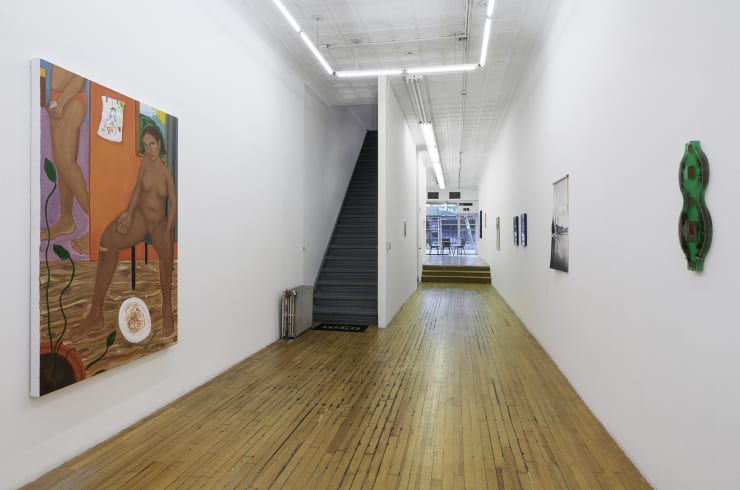A MEETING WITH ERNA SCHILLING: Louise Giovanelli, Nina Hartmann, Mónica Hernández, Merve Iseri, Ernst Ludwig Kirchner, Tessa Perutz, Alice Quaresma, Tracy Thomason
-
 Ernst Ludwig Kirchner, Hockende necktie frau am teetisch, 1912
Ernst Ludwig Kirchner, Hockende necktie frau am teetisch, 1912 -
 Monica Hernandez, Cuando cae el sol
Monica Hernandez, Cuando cae el sol -
 Louise Giovanelli, Palisade, 2019
Louise Giovanelli, Palisade, 2019 -
 Louise Giovanelli, Split Marker, 2019
Louise Giovanelli, Split Marker, 2019 -
 Nina Hartmann, Concave Geographies / The Sublime & The Unattainable, 2019
Nina Hartmann, Concave Geographies / The Sublime & The Unattainable, 2019 -
 Tessa Perutz, Forest Canopy at Nightfall with Orange Path, 2019
Tessa Perutz, Forest Canopy at Nightfall with Orange Path, 2019 -
 Tracy Thomason, All The Ways On The Inside, 2019
Tracy Thomason, All The Ways On The Inside, 2019
Press Release
A meeting with Erna Schilling is an invitation to six female artists to present works in conversation with and in response to Ernst Ludwig Kirchner’s piece, Hockende necktie frau am teetisch, ca. 1912. The gallery takes no position by way of curation, however, observes that there is an ongoing questioning of the roles to be played by female and male artists, the balance of their representation, and the place they occupy in the art market.
Hockende necktie frau am teetisch, ca. 1912, exemplifies key characteristics of Kirchner’s work: speed, motion, and a spontaneous angularity applied to the female nude in an imposed, naturalistic demeanor. His intention was to capture the essence of his subjects as quickly as possible, concentrating on the totality of the experience rather than details.
The human figure, with his studio as the backdrop, was central to his practice. This series of images intimately captured models posing as well as aspects of his bohemian life. Kirchner searched for the means to make work that possessed a sense of immediacy, leading to his fluid, energetic style. Spontaneous sketches and drawings from life (he produced about 20,000 works on paper in his lifetime) were a constant in his practice, and served as a wellspring to his creativity. He considered his drawings as “the purest, most beautiful aspect of his work,” describing them as the "the absolute key to his oeuvre."
In a recent article in The Art Newspaper, Clare McAndrew, author of the Art Basel and UBS Global Art Market Report, is quoted: "There has been an improvement over the past 100 years, but barely over the past 10 years." As for the reasoning, she is baffled: "I don't know. Is it down to demand, or to do with the structure of the art market? Or is it that men and women make different art, and in which case why do we value art that exhibits more 'masculine' attributes more highly? It's a big question, but we need to ask it because if it's not the infrastructure of the market, perhaps we need to change the goalposts. At least we're now asking the question, even if we don't have the answer.”
Louise Giovanelli (1993, London)layers paint in a surrealistic style that simultaneously plays with flatness, translucence, abstraction, and realism. The surface of her paintings, often scratched with fine lines, creates an eerie sense of depth. She lives and works in Manchester UK.
Nina Hartmann (1990, Coral Gables) has a background in zine-making and her current body of work employs photographic images suspended in various colored resin slabs. She lives and works in Los Angeles, CA.
Mónica Hernández (1995, Santiago) creates vivid, colorful, often-nude women in domestic environments. Her narratives and arrangements portray intimate glimpses into the spaces of each of her subjects, revealing a tangible depth and humanity. She was born in 1995 in Santiago, Dominican Republic, currently lives in The Bronx, and works in Brooklyn.
Merve İşeri (1992, Istanbul, Turkey)lush and suggestive environments guide the eye through unconscious associations and vivid fantasies. She is from Istanbul, Turkey and lives and works in London.
Ernst Ludwig Kirchner (1880, Aschaffenburg, Germany – 1938, Frauenkirch-Wildboden, Switzerland) was a German painter, printmaker, and one of the founders of the Die Brücke, the artists' group inspired by primitive art and devoted to raw emotional imagery that flourished in Dresden and Berlin before World War I. He has come to be seen as one of the most talented and influential of Germany's Expressionists.
Tessa Perutz (1988, Chicago) pulls inspiration from the Chicago Imagist painters, and often includes text alongside simple iconography. “[Paintings allows her] to find a meditative and resolved place between the two ends of the spectrum—I can come to terms with my feelings on the proliferation of digital mass media by exploring and enjoying painting analog-based imagery.” She lives and works in Brooklyn and Iceland.
Alice Quaresma (1985, Rio de Janeiro)experiments with the physicality of the photograph. By painting and drawing lines over the photo paper, she reveals the paper’s fragility and limitations. Her work reveals a moment of discovery through the unexpected way the material exists on top of the photograph. She deals with the nostalgia of passing memories and the condition of memory itself as a means to find a sense of belonging. She lives and works in New York City.
Tracy Thomason (1984, Maryland) uses paint and marble dust, hand-mixed into a clay-like material and precisely layered on canvas in geometric configurations. Her richly textured surfaces possess a strong physicality. She lives and works in Brooklyn, NY.









